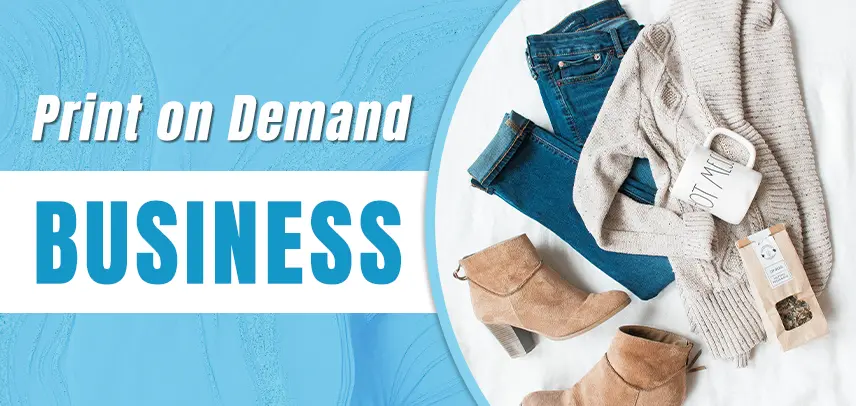
Getting Started With a Print on Demand Business: A Beginner's Guide
Page overview:
6 Steps to Launching Your Print on Demand Business
How to Source Quality Designs While Avoiding Copyright Infringement?
How to Drive Traffic and Sales Through Marketing Outreach?
Master the Art of Social Media Advertising
Immerse Yourself in Niche Communities
6 Steps to Launching Your Print on Demand Business
Building a profitable print on demand business takes an organized approach. Here are the six key steps to launch a POD company:
- Research and validate in-demand niche markets and products with potential for growth and profitability. Examine competitors for gaps your business could fill.
- Brainstorm creative product and design ideas aligned with your chosen niche. Options include creating original artwork, licensing commercial images, or purchasing printable templates and clipart. Always avoid unoriginal or copyrighted work.
- Set up accounts on the leading print on demand platforms such as Inkedjoy and Printful. Upload initial test products and customize your storefront branding and policies.
- Develop your brand identity through logo design, color palette choices, typography, and packaging. Create corresponding social media accounts and email lists to connect with customers.
- Promote your products through targeted social ads, influencer partnerships, search optimization, email campaigns, and other strategies tailored to your niche. Offer special discounts and sales to incentivize purchases.
- Provide excellent customer service and request feedback to continuously refine and expand your offerings. As sales ramp up, reinvest profits into improved products, more compelling marketing, and brand expansion.

How to Source Quality Designs While Avoiding Copyright Infringement?
Perhaps the most crucial component of any print on demand business is finding eye-catching and unique designs. Customers have endless options online, so striking artwork is key to standing out. However, new sellers must avoid copyright violations that can sabotage businesses.
Here are recommended strategies for sourcing original content to use on print on demand products:
- Commission freelance designers or artists to create custom artwork tailored to your niche and brand. Marketplaces like Fiverr and Dribbble offer affordable talent. Be sure to clarify copyright transfer in your agreements.
- Obtain commercial licenses for stock images through providers like Shutterstock, Adobe Stock, and Getty. Carefully read the license terms to confirm the images can be reproduced for commercial sale.
- Utilize public domain images if you can verify the content is no longer under copyright protections. Vintage illustrations often fall under the public domain.
- Create your own designs from scratch using graphic design software like Adobe Illustrator, Affinity, or Procreate. No artistic talent? Try Canva’s editable templates.
- Purchase pre-made digital clip art files to use across products. Sites like Creative Market and Graphic River sell printable graphics for commercial use.
- Remix and edit public domain images by adding overlays, textures, filters, and text. Altered versions have more flexible legal standing.
- Use photo sites like Unsplash, Pexels, and Pixabay to find free images, but always double-check the specific usage licenses.

By proactively sourcing original content or images with commercial usage rights, print on demand sellers avoid legal disputes down the road. Do your due diligence to build a business on ethical and legally compliant creative work.
How to Drive Traffic and Sales Through Marketing Outreach?
Once your print on demand store is operational, the next crucial stage is to foster consistent and effective marketing. Employing a diversified marketing strategy tends to yield the best results. Here’s how:
Engage Your Existing Audience
Don’t underestimate the power of your already-loyal following. Whether it’s through email marketing, social media posts, or content on your YouTube channel, regular engagement helps in keeping your brand on top of their minds.
Master the Art of Social Media Advertising
Facebook and Instagram ads offer targeted options that allow you to zero in on prospective buyers. Their algorithms and demographic targeting tools are invaluable for this sort of business model.
Immerse Yourself in Niche Communities
Platforms like Reddit, Discord, and niche-specific Facebook Groups present unique opportunities for organic growth. Sponsorship and active participation in these communities can offer invaluable brand exposure.
Collaborate for Credibility
Strategically partnering with bloggers and influencers in your industry can significantly amplify your reach. Such collaborations often lend credibility to your brand and drive both traffic and sales.

Content is Still King
High-quality blog content isn’t just for show; it plays a vital role in attracting organic traffic. Content that aligns with your niche interests not only enhances your site’s SEO but also adds value for your audience.
Optimize for Search
Utilizing search engine optimization (SEO) strategies will help you in increasing the visibility of your online listings. Efficient keyword research and optimization can drastically improve your rankings on search platforms.
Master the Email Game
Your email subscriber list is a goldmine. Timely and targeted promotions through limited-time discount codes and new product launches can significantly boost sales.
Monitor, Adapt, and Improve
Keeping a close eye on conversion analytics will help you refine your marketing strategies over time. Constant analysis helps in eliminating ineffective marketing channels and doubling down on what’s working.
By experimenting with a blend of these strategies, tailored specifically to your target audience and niche, you’ll not only boost immediate sales but also create a sustainable growth model for your business.
How to Cope With Common Challenges of Print on Demand?
While the print on demand business model offers numerous advantages, it’s not without its challenges. Smart entrepreneurs anticipate these issues and strategically plan for them. One common challenge is slow initial sales, which often require sustained marketing efforts over several months to build momentum. It’s crucial to remain persistent, as consistent efforts tend to eventually pay off.
Another issue could be errors in orders. These are inevitable and can occur at any stage of the printing process. When they do, the best course of action is to promptly address them by either re-making the product or issuing a refund. Placing blame on customers is counterproductive and can damage your reputation.
Returns are also a part of the business landscape. A customer-friendly return policy can often turn a one-time buyer into a loyal, recurring customer. Therefore, accepting returns graciously is advisable.

Copyright issues are another area that can be problematic. If you find that you’ve inadvertently used copyrighted material, it’s crucial to immediately remove it and pivot to using only original or properly licensed designs.
Diversification is also key. Relying solely on one platform can put your business at risk. Hence, it’s advisable to diversify your offerings across multiple print on demand platforms.
Market saturation is an additional concern. The market might be crowded, but by differentiating your products or venturing into less competitive niches, you can stand out.
Lastly, as your business grows, you’ll find that you have increasing operational demands. It’s a good idea to outsource repetitive tasks, which allows you to focus on high-level growth activities.
Ready to Pursue Your Print on Demand Dream?
Put your trust in Inkedjoy, you can get a flying start with your own print on demand business. With the consistent effort to refine your brand identity, product quality, and customer experiences, your POD shop can shift from a side hobby to a full-time income source. Let your entrepreneurial vision evolve into a profitable print on demand success story!



